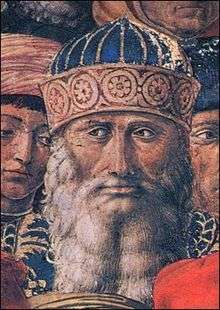Crypto-paganism
A crypto-pagan is a pagan who maintains the pretense of adherence to a non-pagan (e.g. Abrahamic) religion while continuing to observe their own religious practices in private. The term stems from the Greek word kryptos, meaning 'hidden' or 'secret'. This may be in response to a perceived danger of rejection by society, or of formalized persecution by the government, or an established religious organization.
In Classical Antiquity and the early Byzantine Empire
Anthemius, one of the last Roman emperors of the West who ruled from 467 to 472, surrounded himself with prominent pagans such as Messius Phoebus Severus and was believed to hold pagan views. According to Damascius, Severus and Anthemius had a secret plan to restore the Pagan cults.[1] The murder of Anthemius (by Ricimer) destroyed the hopes of those pagans who believed that the traditional rites would now be restored.[2]
Anatolius (Osroene) (died c. 579/580) was a Byzantine official, active in the reign of Tiberius II Constantine (r. 574–582). He was accused of being a crypto-pagan and consequently executed.[3] Acindynus, a Byzantine governor of Carrhae (Harran), was accused by his scribe/secretary Iyarios (elsewhere called Honorius) of secretly practicing paganism. Stephen, Bishop of Harran, had Acindynus executed in 602, either by impalement or crucifixion. The deceased governor was succeeded by Iyarios.[4][5]
In an article entitled The Corpus Areopagiticum as a Crypto-Pagan Project, Tuomo Lankila of the Universities of Helsinki and Jyväskylä argues that the Corpus Areopagiticum, an ostensibly Christian text attributed to Pseudo-Dionysius the Areopagite, was in fact written by Damascius, the last head of the pagan Neoplatonist school of Athens. The article suggests that the work was written "in order to resurrect more easily the polytheistic religion in better times".[6]
In the Middle Ages

The process of the Christianization of Europe typically involved Christian missionaries managing to convert a King or other ruler who then proclaimed his kingdom to be Christian. It certainly took several generations for Christianity to become truly established in the whole society, with many people - especially in rural and outlying areas - clinging for long to their ancestral religion, deemed "Pagan" from the Christian point of view. With the Church establishing its hierarchy and a network of parish priests, such practices were increasingly driven underground. Alternately, the Church in some cases gave some widespread practices a Christian guise, for example attributing annual processions or rites, dedicated to a local deity, to a Christian Saint instead; it is likely that in many such cases the formally-Christian people continued for some generations to invoke the original deity.
The Byzantine philosopher Gemistus Pletho (c. 1355/1360 – 1452/1454) secretly advocated polytheism in his book Nomoi, which he only circulated among close friends. After his death it came into the hands of the Ecumenical Patriarch of Constantinople Gennadius II, who eventually burned it, although Gennadius' summary of its content survives in a letter.
In the modern world
In modern society, particularly in regions of strong conservative religious belief, contemporary pagans will sometimes also seek to present the impression of conformity to the mainstream in order to mitigate the risk of ostracism or persecution. Many refer to this as "staying in the broom closet", a reference to an LGBT person remaining "in the closet" to hide their sexual or gender identity.
In Wicca, as presented by Gerald Gardner, traditional laws instruct practitioners to conceal their practices and religious paraphernalia by using innocuous substitutes which could easily be explained away in case of discovery:
"To void discovery, let the working tools be as ordinary things that any may have in their houses. Let the Pentacles be of wax, so they may be broken at once. Have no sword unless your rank allows you one. Have no names or signs on anything. Write the names and signs on them in ink before consecrating them and wash it off immediately after. Do not Bigrave them, lest they cause discovery. Let the colour of the hilts tell which is which. Ever remember, ye are the Hidden Children of the Gods."[7]
Among modern guides, City Magick, an urban pagan's manual published in 2001, gives examples of how to hide a pagan altar at your home or at work, using items such as letter openers, paper weights, and coffee cups and relaxation candles in the place of the traditional sword, stone, goblet and candle.[8]
In Indonesia, Sunni Islam, Protestantism, Catholicism, Hinduism, Buddhism and Confucianism are the only religions officially recognised by the government. Indonesians may leave the religion entry blank or, as of 2017, may list another (not officially recognized) religion on their national identity card.[9] Followers of local religions often identify themselves as followers of one of these official six religions, to avoid being denied public service.
See also
References
- Damascius, Vita Isidori in the Epitome by Photius, cited in MacGeorge, Penny, Late Roman Warlords, Oxford University Press, 2002, ISBN 0-19-925244-0, p. 52.
- Marcellinus Chronicle s.a. 468
- Martindale, Jones & Morris (1992), pp. 72–73
- Martindale, John Robert; Jones, Arnold Hugh Martin; Morris, J., eds. (1992). The Prosopography of the Later Roman Empire. III: A.D. 527–641. Cambridge, United Kingdom: Cambridge University Press. pp. 10–11. ISBN 978-0-521-20160-5.
- Palmer, Andrew; Brock, Sebastian P.; Hoyland, Robert (1993). The Seventh Century in the West-Syrian Chronicles. Liverpool, United Kingdom: Liverpool University Press. pp. 114–115 (including footnotes). ISBN 978-0-85323-238-4.
- Lankila, Tuomo (2011). "The Corpus Areopagiticum as a Crypto-Pagan Project" (PDF). Journal for Late Antique Religion and Culture 5. ISSN 1754-517X. Retrieved 28 December 2012.
- "Gardnerian Book of Shadows: The Old Laws". sacred-texts.com. Retrieved 28 December 2012.
- Christopher Penczak. City Magick. Weiser books. pp. 106–120. ISBN 1-57863-206-4.
- "Indonesia 2018 International Religious Freedom Report" (PDF). United States Department of State. Retrieved January 2, 2020.
External links
- Jones "The Roman Economy" – Section with crypto-pagans and neo-platonic faiths